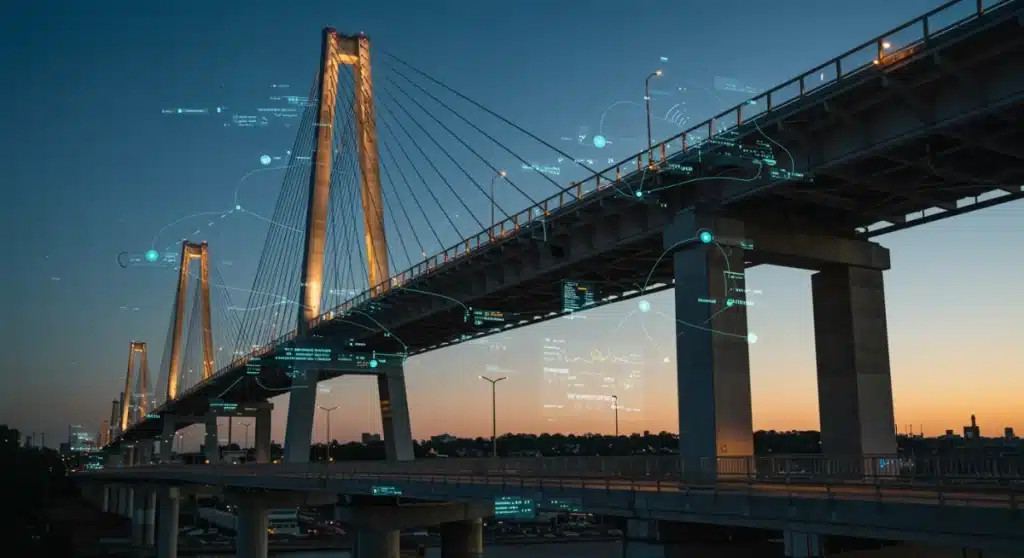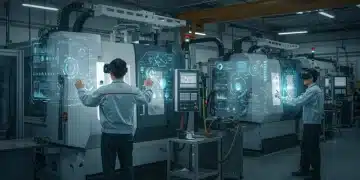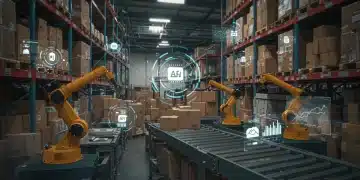Advanced Sensor Technology: Monitoring Infrastructure Health with 99% Accuracy by 2026

Advanced sensor technology is rapidly transforming infrastructure health monitoring, targeting an unprecedented 99% accuracy by 2026, ensuring early detection of structural issues and significantly boosting public safety and operational efficiency.
The future of urban resilience is here, driven by breakthroughs in Advanced Sensor Technology: Monitoring Infrastructure Health with 99% Accuracy by 2026. This critical development promises to revolutionize how we safeguard essential structures, moving from reactive repairs to proactive, predictive maintenance. What does this mean for our cities and public safety?
The Dawn of Predictive Infrastructure Maintenance
Predictive maintenance is no longer a futuristic concept; it is becoming a reality for critical infrastructure. Advanced sensor systems are being deployed globally to collect real-time data on the structural integrity of bridges, roads, pipelines, and buildings. This shift is crucial for preventing catastrophic failures and extending the lifespan of vital assets.
Recent reports highlight a significant push towards integrating artificial intelligence with these sensor networks. This combination allows for sophisticated data analysis, identifying potential weaknesses long before they become visible to the human eye. The goal is clear: achieve near-perfect accuracy in detecting and predicting structural degradation.
Real-time Data Collection and Analysis
The ability to collect data continuously is a cornerstone of this technological revolution. Sensors embedded within infrastructure components constantly measure various parameters, such as stress, strain, temperature, vibration, and corrosion levels. This constant stream of information provides an unparalleled view into the health of our built environment.
- Vibration Monitoring: Detects subtle shifts and oscillations that indicate structural fatigue or damage.
- Strain Gauges: Measures deformation in materials, signaling potential overloads or material degradation.
- Temperature Sensors: Monitors thermal expansion and contraction, which can impact material integrity over time.
- Corrosion Sensors: Identifies early signs of rust and material breakdown in metallic structures.
These data points are then fed into powerful analytical platforms that use machine learning algorithms to identify patterns and anomalies. This process not only flags immediate concerns but also predicts future behavior, allowing engineers to intervene precisely when and where it’s most needed.
Enhancing Safety and Reducing Costs with Smart Sensors
The primary benefit of advanced sensor technology in infrastructure monitoring is the dramatic enhancement of public safety. By identifying potential failure points early, authorities can take preventative action, avoiding collapses, accidents, and disruptions. This proactive approach saves lives and protects property, transforming how we manage risk in urban environments.
Beyond safety, the economic implications are substantial. Traditional maintenance often involves costly, scheduled inspections and repairs, regardless of actual need. Predictive maintenance, powered by sensors, allows for targeted interventions, significantly reducing operational expenses and extending asset life. This efficiency translates into considerable savings for municipalities and infrastructure operators.
The Economic Impact of Proactive Monitoring
Investing in advanced sensor systems yields a strong return on investment. By avoiding major repairs and catastrophic failures, organizations save billions annually. This includes not only direct repair costs but also indirect costs associated with traffic disruptions, environmental damage, and legal liabilities. The ability to prioritize maintenance based on actual structural health optimizes resource allocation.
- Reduced Repair Costs: Addressing minor issues before they escalate into major problems.
- Extended Asset Lifespan: Proactive maintenance prevents premature degradation, making infrastructure last longer.
- Minimized Downtime: Scheduled, precise interventions cause less disruption than emergency repairs.
- Optimized Resource Allocation: Directing funds and personnel to areas of greatest need.
Governments and private entities are increasingly recognizing these economic advantages, driving further investment in sensor-based monitoring solutions. The long-term savings and increased reliability make a compelling case for widespread adoption.
Leveraging AI and Machine Learning for Unprecedented Accuracy
Achieving 99% accuracy by 2026 in infrastructure monitoring hinges on the sophisticated integration of Artificial Intelligence (AI) and Machine Learning (ML). These technologies are not merely data processors; they are intelligent systems that learn from vast datasets, recognize complex patterns, and make increasingly accurate predictions about structural health. This capability moves beyond simple threshold alerts to nuanced risk assessments.
AI algorithms can analyze historical data, environmental factors, and real-time sensor readings to identify subtle indicators of stress or fatigue that human inspectors might miss. This continuous learning process refines the models, making them more precise over time. The goal is to provide actionable insights that allow for timely interventions, preventing issues before they become critical.
Advanced Data Fusion and Pattern Recognition
The power of AI in this context comes from its ability to fuse data from multiple sensor types and external sources. For instance, combining vibration data with temperature fluctuations and traffic load information provides a comprehensive picture of a structure’s health. ML models excel at identifying correlations and anomalies within this fused data, predicting potential failures with high confidence.
Pattern recognition algorithms can detect deviations from normal operational parameters, even if those deviations are minor. These subtle shifts, when accumulated over time, can indicate significant structural issues. AI’s capacity to process and interpret these complex patterns is what drives the push for near-perfect accuracy in monitoring.
The Role of IoT in Connecting Infrastructure
The Internet of Things (IoT) is the backbone connecting the myriad of sensors deployed across infrastructure. IoT platforms enable seamless data transmission from remote sensors to centralized analytical hubs. This connectivity ensures that real-time data is available for immediate processing and analysis, regardless of the sensor’s physical location.
IoT devices are designed to be low-power and robust, capable of operating in harsh environments for extended periods. Their ability to communicate wirelessly and securely is fundamental to creating a comprehensive, interconnected monitoring network. This network forms the nervous system of smart infrastructure, constantly feeding vital information.

Scalability and Remote Management
One of the key advantages of IoT in this application is scalability. As more infrastructure components are equipped with sensors, the IoT framework can expand to accommodate the increased data flow. Furthermore, remote management capabilities allow for firmware updates, diagnostics, and configuration changes to be performed without physical access to each sensor, significantly reducing maintenance overhead.
- Wireless Connectivity: Enables data transmission from hard-to-reach locations.
- Low Power Consumption: Ensures long battery life for sensors in remote areas.
- Secure Data Transmission: Protects sensitive infrastructure data from cyber threats.
- Cloud Integration: Facilitates large-scale data storage and access for AI/ML analysis.
The widespread adoption of IoT protocols and standards is making it easier and more cost-effective to deploy these sophisticated monitoring systems across diverse infrastructure types.
Challenges and Future Outlook for Sensor Integration
While the prospects for advanced sensor technology are bright, several challenges remain in achieving widespread integration and the ambitious 99% accuracy target by 2026. These include the high initial cost of deployment, the complexity of managing vast datasets, and ensuring the long-term reliability and cybersecurity of sensor networks. Overcoming these hurdles requires collaborative efforts from governments, industry, and academia.
Standardization of sensor technologies and data protocols is also critical for seamless integration and interoperability. Without common standards, different systems may struggle to communicate effectively, hindering the creation of a truly interconnected smart infrastructure. Addressing these challenges is paramount for the full realization of the technology’s potential.
Overcoming Deployment and Data Management Hurdles
The initial investment for deploying thousands or millions of sensors across an entire city’s infrastructure can be substantial. However, the long-term savings and safety benefits often outweigh these upfront costs. Strategies like phased deployment and public-private partnerships are being explored to mitigate financial barriers.
Managing the immense volume of data generated by these sensors presents another significant challenge. Big data analytics platforms and cloud computing resources are essential for processing, storing, and extracting meaningful insights from this continuous stream of information. Developing robust, scalable, and secure data management solutions is an ongoing priority.
The Path to 99% Accuracy by 2026: A Collaborative Vision
The ambitious goal of achieving 99% accuracy in infrastructure health monitoring by 2026 is a testament to the rapid advancements in sensor technology, AI, and IoT. This target is not merely a technical benchmark; it represents a commitment to enhanced public safety, economic efficiency, and environmental sustainability. It requires a concerted effort from all stakeholders.
Governments are investing in smart city initiatives, researchers are pushing the boundaries of sensor capabilities, and private companies are developing innovative solutions. The convergence of these efforts is creating a powerful ecosystem dedicated to building more resilient and intelligent infrastructure for future generations. This collaborative vision is driving us towards a safer, more sustainable world.
Key Drivers for Achieving High Accuracy
Several factors are converging to make this high accuracy achievable. Continuous innovation in sensor materials and miniaturization allows for more discreet and durable deployments. Advances in AI and machine learning algorithms are making data interpretation more precise and predictive. Furthermore, the increasing availability of computational power and cloud infrastructure supports the massive data processing requirements.
- Material Science Innovations: Developing more durable and sensitive sensor materials.
- AI Algorithm Refinements: Improving predictive models for early anomaly detection.
- Edge Computing: Processing data closer to the source for faster insights.
- Interdisciplinary Collaboration: Bringing together experts from engineering, data science, and urban planning.
The collective progress in these areas is accelerating the journey towards highly accurate and reliable infrastructure monitoring systems, making the 2026 target increasingly plausible.
| Key Point | Brief Description |
|---|---|
| 99% Accuracy Target | Goal for advanced sensor technology in infrastructure monitoring by 2026, ensuring high reliability in defect detection. |
| Predictive Maintenance | Shifting from reactive repairs to proactive interventions based on real-time sensor data and AI analysis. |
| AI and IoT Integration | Artificial intelligence and the Internet of Things are crucial for data processing, pattern recognition, and connectivity. |
| Enhanced Public Safety | Early detection of structural issues prevents failures, safeguarding lives and property, and reducing emergency costs. |
Frequently Asked Questions About Advanced Sensor Technology
It involves deploying sophisticated sensors on structures like bridges and buildings to collect real-time data on their condition. These sensors measure parameters such as vibration, stress, and temperature, providing continuous insights into structural health and potential issues.
AI algorithms analyze vast amounts of sensor data, identifying subtle patterns and anomalies that indicate structural degradation. This machine learning capability allows for highly accurate predictions of potential failures, significantly improving the reliability of monitoring systems.
The primary benefits include enhanced public safety by preventing catastrophic failures, reduced maintenance costs through targeted interventions, and extended lifespan of infrastructure assets. It shifts from costly reactive repairs to efficient proactive measures.
The Internet of Things (IoT) provides the crucial connectivity for advanced sensor networks. It enables seamless, real-time data transmission from remotely located sensors to centralized analytical platforms, forming an interconnected system for comprehensive monitoring.
Challenges include the high initial deployment costs, the complexity of managing massive datasets, and ensuring the long-term reliability and cybersecurity of sensor networks. Standardization of technologies and data protocols is also a significant hurdle to overcome for broader integration.
Looking Ahead: The Resilient Infrastructure of Tomorrow
The drive towards 99% accuracy by 2026 in infrastructure monitoring with advanced sensor technology signifies a profound shift in how societies manage their critical assets. This isn’t just about technological prowess; it’s about building a safer, more sustainable, and economically resilient future. What happens next involves continued investment in research and development, fostering greater public-private sector collaboration, and establishing robust regulatory frameworks to ensure these technologies are deployed effectively and securely. The implications for urban planning, disaster preparedness, and resource management are immense, promising a new era of infrastructure reliability.





